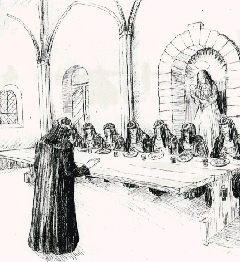Meet the Middle Ages
BackVadstena - the Brigittines´ convent

There were many monasteries and nunneries in Sweden during the late Middle Ages. One of the most important in Europe lay in Vadstena.
St. Birgitta had been told by God to found a religious order. In 1384, eleven years after St. Birgitta ´s death, the Pope gave his permission. Birgitta had herself decided how the convent in Vadstena should be organised. There should be a monastery with 13 monks and a nunnery with 60 nuns. The leader of the nuns, the abbess, was in charge. Birgitta had also decided how the buildings should be constructed.
The nuns embroidered beautiful vestments and altar-cloths or copied books. Some of them knew a lot about health-care. Remedies were prepared from herbs grown in their own garden. The nuns never left the nunnery.
The monks said Mass and heard confessions, at the monastery as well as in town. They did other work as well. One may have been a skilled watchmaker. Others knew the art of making window-glass. The convent in Vadstena was very rich, owning large estates and many farms. Therefore, many monks were busy taking care of the accounts.
Six times a day, the monks and nuns met to say prayers. They had short services where they sang, prayed and recited the Bible.
The convent in Vadstena had a large library and was a cultural centre in Sweden.
Around the Baltic Sea, more Brigittine monasteries and nunneries were founded, for example in Mariager and Maribo in Denmark and in Tallinn in Estonia. These were all destroyed during the reformation in the 16th century.